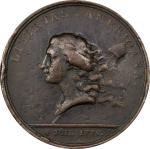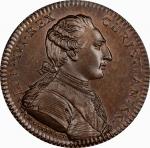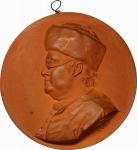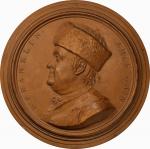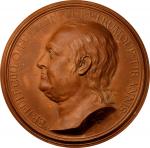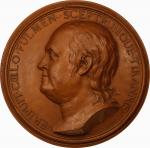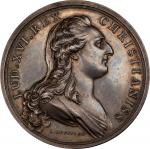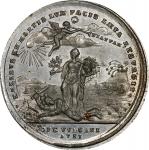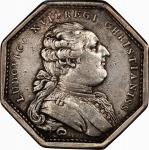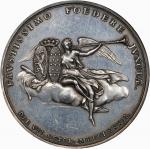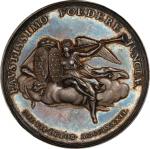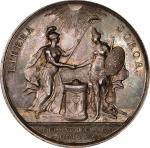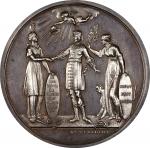1783 Felicitas Britannia et America Medal. Betts-614. White metal, 38.5 mm. EF-40 (PCGS).Glossy and lovely, with choice appearance and luster, this is one of the great highlights of Syd Martins Betts medals. He bought it from our John W. Adams Collection sale in November 2015, where we described it (in part) as follows:
"The surfaces are lively for one of these, retaining hints of silvery luster around design elements on both sides. Elsewhere, the fields have mellowed to pleasing pewter gray, even and appealing. No heavy marks are present, nor any of the seeming attempted punctures seen on so many specimens of this rarity. A light old scratch crosses between TA of FELICITAS to the field above St. Pauls, and a few other trivial scrapes are seen in the upper right obverse. The rims and edges are intact and well-preserved. The planchet is well made, with no visible defects from its initial casting."
Back in 2015, your cataloger still puzzled over all the similarities between this Betts number and the 1776-dated Continental dollars. I posited an American origin based upon the received wisdom of the origin and intent of the Continental dollars. A lot has changed in eight years, thanks to research by David McCarthy, Erik Goldstein, and others, and suddenly this medal makes much more sense. Back in the Adams sale, we noted that some prime evidence against an American origin for this medal was the predominance of English provenances among known examples, citing the 2010 Baldwins sale of an example from an English cabinet formed before 1852, and the fact that these were so rare in the United States before 1875:
"Two specimens were identified in American collections before 1875, as cited by Crosby in <em>Early Coins of America</em>, one in the collection of William Sumner Appleton, the other owned by Henry Holland. Appleton first published his in 1866. Dr. Charles Clay of Manchester, England owned one, sold in New York in the 1871 auction of his collection, along with dozens of other American colonial pieces. By the time of the 1882 Bushnell sale, the Chapman Brothers reported that four or five were known."
Somewhere in the range of 15 specimens survive today. Most are not very attractive, and a substantial proportion have partial drillholes on them. Few are fully Mint State. This specimen is among the most famous, as the Garrett Collections inclusion of this medal with their Continental dollars set a trend that was more appropriate than most realized. The Norwebs and John J. Ford, Jr. did the same. There was only one in the John Ford collection, sold in our Ford I sale of 2003 along with his Continental dollars. Eric Newman owned one, a low grade piece formerly from Col. E.H.R. Green, also sold with his Continental dollars. Others have graced the cabinets of Lucien LaRiviere and Mrs. Norweb, whose specimen brought over $88,000 in the 2015 Partrick sale. That example, graded NGC AU-55 and only a little nicer than this, was also sourced from the cabinets of Baldwins in London. Partricks duplicate, a very pleasing NGC F-15, brought $18,000 in June 2021. We resold the Garrett specimen in our November 2020 E Pluribus Unum II sale, graded EF Details, Damage (PCGS) for $13,200. The C.W. Betts piece is in the collection at Yale, the Charles P. Senter example is in the American Numismatic Society, the LaRiviere medal is now at Colonial Williamsburg, and the Boyd duplicate (ex Bowers and Ruddys Scott sale of 1975) is at Mount Vernon. Along with the example in the British Museum, no fewer than five examples are impounded, perhaps a third of the entire population. Many, even most, are low grade, indicating that this medal was intended for popular consumption, not for the cabinets of the upper class.
By any accounting, this is one of the most important of all Revolutionary War medals, a crude foil to the elegance of the Libertas Americana medal, juxtaposed with consecutive numbers in Betts and struck within months of each other. While the Libertas Americana medals story is told with reams of original documentation, letters from Benjamin Franklin, sketches and models and more, the story of the Felicitas Britannia et America medal is a numismatic pantomime, silent but expressive, with no evidence more than the medals themselves. The obverse is suggestive: a London skyscape, prominently including St. Pauls Cathedral; crude renditions of a standing goddess America and the seated Britannia, the latter reminiscent of some of the crudest base metal medalets of George IIIs reign; an exergual date of one day after the finalizing of the Treaty of Paris; and a reverse that is an exact copy of the Continental "dollar," clearly rendered by the same hand and struck in the same composition, all finished with an edge device that is essentially identical to that seen on the Continental dollars. Also, interestingly, the reverse die alignment of the Betts-614s and Continental dollars are along the same axis, though on Continental dollars the reverse is aligned roughly 45 degrees right of medal turn while on these the reverses are aligned 45 degrees right of coin turn. In an ironic twist, these are closer to coin turn and the Continental dollars are closer to medal turn.
For decades, numismatists (including this cataloger) tried to explain away the obvious: that a medal depicting Londons skyline must have been an English medal but is somehow just like the evidently American Continental "dollar." The well-documented research that proved the Continental "dollars" were actually English medals struck ca. 1783 makes this medal far easier to understand. That the two pieces came from the same shop now seems obvious; that it was made in England for an audience that clamored for anything having to do with the exciting new nation across the Atlantic seems no less evident. Such as most Continental dollars have provenances that lead back to England, so too does the Betts-614. The principal difference between this medal and the Continental dollar, beyond the cosmetic, is this medal is at least an order of magnitude rarer.PCGS# 541631.<strong>To view supplemental information and all items from the Sydney F. Martin Collection, click<a href="https://stacksbowers.com/sydney-f-martin-collection/"target=’_blank’> here.</a></strong>.From the Sydney F. Martin Collection. Earlier ex A.H. Baldwin and Sons, Ltd.; John J. Ford Jr. to John W. Adams; December 1984; our sale of the John W. Adams Collection, November 2015, lot 23089.

